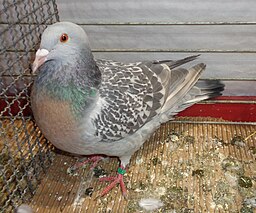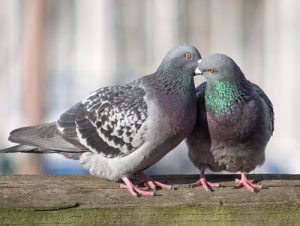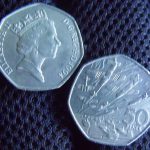
You probably know that ‘pigeon fancier’ is the common term used for someone who keeps and breeds pigeons as a hobby. The genteel pastime of pigeon fancying is practiced by millions across the globe. Famous pigeon fanciers of past and present include Mike Tyson, George Foreman, Charles Darwin, Pablo Picasso, Queen Elizabeth II, and Walt Disney. Ever fancied joining the ranks of the pigeon fancier? Here’s a brief narrative on pigeons and pigeon keeping:
The Pigeon Family
There are well over 300 extant pigeon species in the world, all of which belong to the Columbidae family. The word “pigeon” also encompasses the dove, since scientifically speaking, they are indistinguishable. As it turns out, the word “dove” has its roots in the Nordic languages, whereas “pigeon” has been borrowed from French. However, the general acceptance now is that talk of a “dove” refers to the smaller, long-tailed members of the pigeon family.
Many of the world’s wild pigeon species face the same challenges as the general bird population. Like many avian species, their numbers are currently in decline. This is mainly due to man’s destruction and degradation of their habitat, as well as the effects of climate change. However, serendipity has seen a few pigeon species thrive despite the marked increase in negative environmental impacts. If global proliferation is deemed a measure of success, then the domestic pigeon is one of the most successful of all birds. Experts believe that the worldwide domestic pigeon population, largely made up of feral birds, could be over 400 million.
The Domestic Pigeon

Photo credit: Wikimedia/CC BY-SA 4.0
The domestic pigeon (Columba livia domestic) is a species of pigeon that descends from the rock dove. It is thought the latter was first tamed in Mesopotamia (present-day Iraq) as early as 10,000 years ago. Pigeons have been bred and cultivated by mankind ever since. Historically, they have been utilised as a food source, as pets, as messengers, and for use in religious ceremonies.
Today, keeping pigeons is a popular pastime as well as a business. There are currently more than 800 different breeds of domestic pigeons recognised across the world. The breeds are grouped into three main categories, which see them classified as either racing, show or utility pigeons.
Racing Pigeons
The racing pigeon or homing pigeon, was historically bred for its uncanny navigation skill, endurance and speed. These qualities were developed over centuries of selective breeding to see the birds become effective long-distance messengers. The use of the messenger pigeon became an essential tool in antiquity, especially during times of conflict. Later, the pigeon was utilised by famous leaders such as Julius Caesar, Hannibal and Genghis Khan. The pigeon was also used in both World Wars, delivering around 90% of all messages. Their descendants are the breeds that are now engaged in the sport of pigeon racing.
Show Pigeons
Show or fancy pigeons are bred by pigeon fanciers to produce birds of various shapes, colours and/or behavioral traits. The birds are then often exhibited in competitions at various pigeon shows, fairs and livestock exhibitions. The show pigeon group also includes flying tumblers and highflier breeds that participate in acrobatic flying competitions. Also known as sporting breeds, they are now often only reared for showing rather than for participation in flying tournaments.
Utility Pigeons
Utility pigeons are those domestic pigeons that were once bred purely as a source of meat. Pigeon meat production is referred to as squabbling, while the meat itself, like a young pigeon, is known as ‘squab’. Ulitilty breeds have the potential to grow and breed quickly. Squab meat production was once popular across much of the world but is much less so today. Even in the once-stronghold of North America, squabbing has been in decline since the beginning of the 20th century. Today, designated utility breeds are often reared for showing rather than eating.
Pigeon Keeping

Photo credit: Flickr/CC BY-NC 2.0
If you have an interest in keeping pigeons, here’s some basic advice:
Housing
The pigeon is a hardy bird but still needs a comfortable, safe place to roost. Depending on the number of birds, they are usually housed in either a timber loft or dovecote. Shelters should be well-ventilated and roomy enough for the birds to move around freely. The addition of a flight pen allows the pigeons access to fresh air and sunlight while protecting them from predators.
Nesting
Pigeons are monogamous and typically share the responsibility of incubating eggs and caring for their squabs. It is best to provide purpose-built nesting boxes inside the loft for the birds to utilise.
Feeding
Pigeons have a varied diet that includes a variety of grains and seeds, as well as commercially produced pigeon feed. Their diet should be supplemented with minerals and grit to aid digestion. A source of fresh, clean water should be readily available and changed regularly.
Healthcare
Pigeons should be monitored regularly for signs of illness. Birds can carry viral, bacterial and parasitic diseases, many of which are often not greatly understood. Thus, prevention is better than cure, which can be done by creating good sanitary conditions.
Training & Exercise
Pigeons must have plenty of regular flight exercise. This sees many enthusiasts train their birds for formal racing events. The training usually involves gradually increasing the distance from the point where the birds are released, back to their lofts. The distance and times of the birds’ return flights are then monitored to chart their progress.
Cleaning
Clean out lofts and dovecotes regularly to prevent health issues with your birds.
Local Regulations
Check out local laws and regulations that may apply to keeping pigeons in your area.
Local Clubs
Join a local pigeon club where you can get expert support and advice from experienced pigeon enthusiasts.
Header image credit: Pixabay/PDM 1.0 DEED



